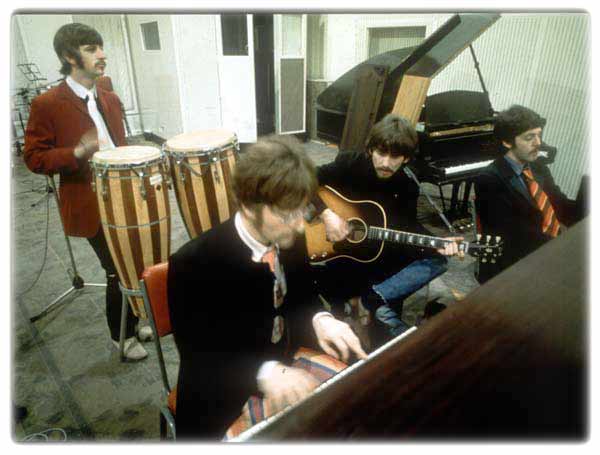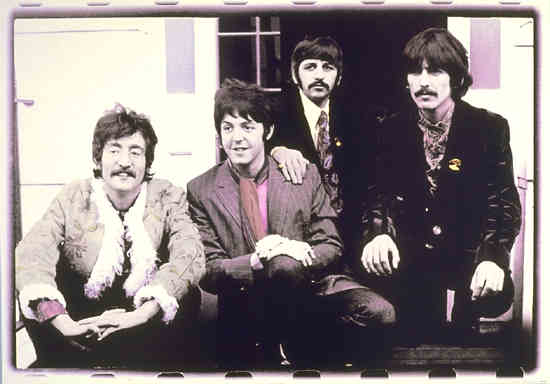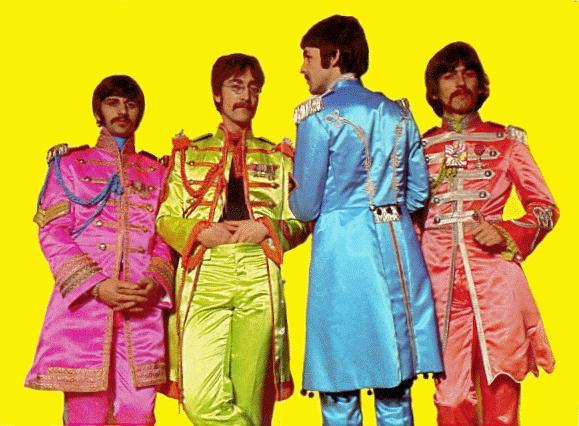 |
| 1966 [RS
and JL 25-26; PMc 23-24; GH 22-23; George Martin 39-40] |
The Concept
With touring now off the list of Beatles priorities, they turned their
attention to their continued transformation. With Revolver, they
had begun to transform their image and how they wanted people to perceive
them. Given the tectonic psychedelic shifts taking place in mid-sixties
Western civilization, the Beatles responded in the way they always had:
they aimed to best the competition. Unlike 1963, when they first shocked
listeners in the UK and then the cosmopolitan world, they knew other musicians
would be watching. 1966 would see some remarkably new ideas for popular
music, and some new remarkable musicians. While guitar soloists had long
been idols in rock culture (consider their British forebears and contemporaries
such as Hank Marvin of the Shadows), they now knew guitar virtuosos like
Eric Clapton, Jeff Beck, Jimmy Page, and — towards the end of this year,
an astounding "new" figure — Jimi Hendrix. George Harrison had always
been a hardworking and proficient guitarist, but he was no match for these
guitar heroes. Brian Epstein had convinced them to trade in their leathers
for matching designer suits and to behave (like him) ultra-politely on
stage. Now, musicians like the Who smashed their instruments and wore
bright bold colors and shapes and/or lace (consider the Kinks). Where
the Beatles had always treated the stage like the bar they had endured
in Hamburg and Merseyside, singers like Mick Jagger began to strut as
though he was on a fashion runway. Almost as important, the straight out
rock singing style favored by John Lennon seemed rather simple compared
to those who imitated either the highly ornamented American blues and
gospel styles. Lennon had almost immediately stopped playing the harmonica
after he heard performers like Brian Jones, Cyril Davies, and Kieth Relf.
Now he sought other ways to distinguish his voice. |
| Of course, much of the change
in mid-sixties culture was a consequence of what the Beatles themselves
had been doing. The pop world now featured sitarists (and would-be sitarists)
and musicians whose ideas were breaking away from the two-minute-and-30-second
pop single format (e.g., the Who and Pink Floyd). And of course, their
collarless suits had been part of the original clothing revolution. Nevertheless,
they knew as they began work on their next album that they either scored
big, or began sliding out of spotlight. Although they and George Martin
have denied it, their original plans seem to have included a series of
vignettes of their past, or at least an ideational place of safety and
predictability. "Penny Lane" and "Strawberry Fields Forever" point to
a Liverpudlian past tense. But with the early release of these recordings
to fill a void in the coffers of Capitol records and its parent company,
EMI (and probably to squelch rumors and predictions by members of the
press that the Beatles were about to break up and that they had exhausted
their creativity), they began to modify that plan. They had already begun
recording "When I'm Sixty-four" and as they proceeded adding tunes, the
direction became increasingly apparent, at least to McCartney. |
| |
| 1967 [RS
and JL 26-27; PMc 24-25; GH 23-24; George Martin 40-41] |
| Sgt. Pepper's Lonely Hearts
Club Band would be a fin-de-siècle ensemble from an age of relative
Edwardian innocence: a brass band in colorful uniforms and the mustaches
and whiskers of that era. These, of course, were the glory days of the
Music Hall and this seems to be the venue into which they invite the listener.
Of course, while the Beatles had not been part of the Music Hall tradition,
they had played in halls that had been on that circuit; moreover, they
knew the conventions of the idiom from their childhoods. |
 |
| However, Sgt. Pepper's
Lonely Hearts Club Band is an elaborate set of contradictory metaphors.
The image of Sgt. Pepper, like Londoners of the late sixties, acknowledges
a far-off war with his military rank and uniform. However, the music and
the elaborateness of the costume purposely ignore the real war and deny
the validity of its existence. The variety of characters, scenes, and
musical styles that follows between the introduction and finale suggests
an optimistic worldview in which individuals are independent, free, and
loved and things are "getting better all the time." Even the police are
friendly in this reality. |
| An integral tool in their
construction of this reality was the cover. Their album covers had increasingly
taken on metaphoric value, whether the warped mirror image of Rubber
Soul or Klaus Voorman's collage for Revolver. Peter Blake's
package concept for Sgt. Pepper's took the idea even further. They would
include the texts of the songs (usually believed to be a first time for
a pop album) which would extend the metaphoric impulse by encouraging
textual analysis. The deluxe color folded sleeve with its childlike mustache
and striped cut outs took its inspiration in the pop images already displayed
prominently on albums such as the Who's A Quick One (1966). However,
the paraphernalia invited the listener to join the band, pulling the audience
even deeper into the illusion. And as if to illustrate that others had
already joined the band, Blake placed figures of individuals who had influenced
the Beatles around them in a format that much of their teenage audience
would have understood: the school picture. Perhaps the idea was for everyone
to join this psychedelic army band. In the end, the Beatles spent more
money and energy on this cover than most bands and companies spent on
audio production. Notably, they were no slackers when it came to audio
production. |
| January-February. The
Beatles work on "Penny Lane," "A Day in the Life," "Sgt. Pepper's Lonely
Hearts Club Band," Good Morning Good Morning," "Being For the Benefit
of Mr. Kite!," and "Lovely Rita." They also film material for the promotional
clips for "Strawberry Fields Forever" and "Penny Lane." |
| 17 February. EMI releases
"Strawberry Fields Forever" and "Penny Lane" in the UK. (Capitol released
the single on the 13th.) |
| March. They continue
recording and overdubbing material for the album, beginning with "Lucy
in the Sky with Diamonds," "Getting Better," "Within You Without You,"
She's Leaving Home," and "With a Little Help from My Friends." |
| April-May. The Beatles
begin work on Magical Mystery Tour and and material for Yellow
Submarine while finishing production work began on Sgt. Pepper's
Lonely Hearts Club Band. |
| 20 May. Kenny Everett
has a special feature on Sgt. Pepper's Lonely Hearts Club Band featured on the BBC Light Programme show, Where It's At. The special
will premier every track but one (the BBC had already banned "A Day in
the Life" for promoting drug use) along with interviews with each of the
Beatles. |
| 1 June. EMI releases Sgt. Pepper's Lonely Hearts Club Band (Parlophone PMC/PCS 7027).
[The Capitol release in the US and Canada was the following day.] |
| Under a new contract with
EMI, this release marks the first time that a Beatles album would appear
with the same contents on both sides of the Atlantic. The days of Capitol
executives carving up the UK Beatles albums to create multiple American
releases was over. |
 |
| Sgt.
Pepper's Lonely Hearts Club Band |